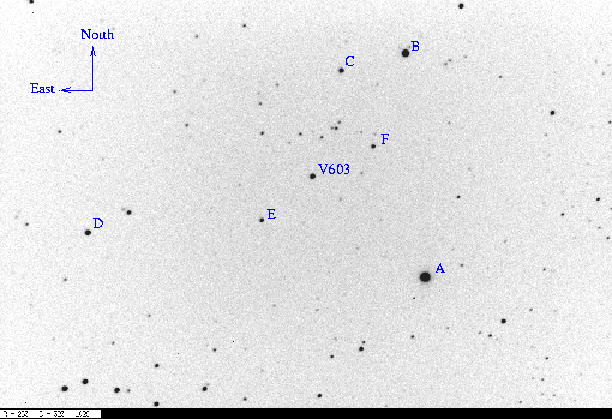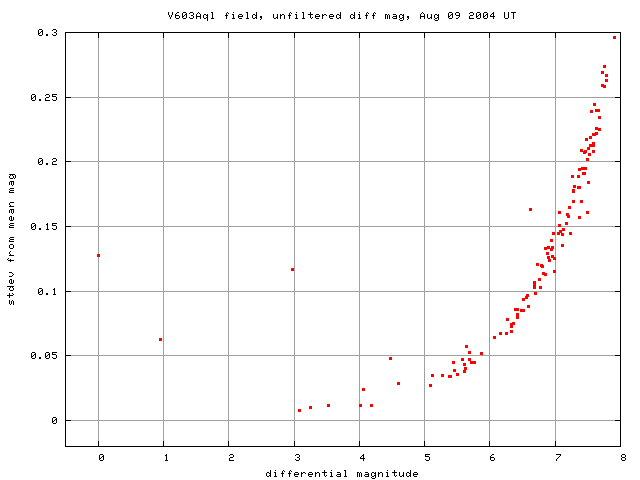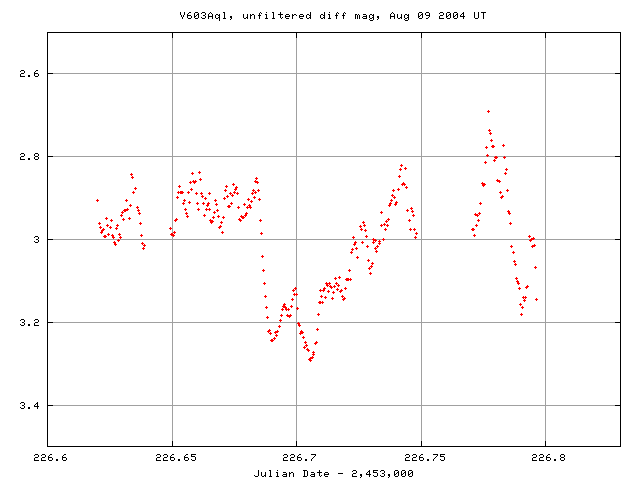
On the night of August 8/9, 2004 EDT, I used the RIT Observatory's 12-inch Meade telescope and SBIG ST8 CCD camera to monitor the star V603 Aql, a cataclysmic variable under study by the Center for Backyard Astrophysics.
The plan:
Notes from the night
Here's a chart of the field of V603 Aql, taken last year with our equipment; the field is about 20 arcminutes wide.
Note that
I measured the instrumental magnitude of each star with aperture photometry, using a radius of 4 pixels = 7.4 arcseconds, and sky defined by an annulus around each star. Following the procedures outlined by Kent Honeycutt's article on inhomogeneous ensemble photometry, I used all stars available in each image to define a reference frame, and measured each star against this frame.
Below is a graph of the scatter in differential magnitude versus magnitude. Note that star "A" (the brightest, at differential magnitude 0) is very saturated, and star "B" (next brightest, at diff mag = 1.0) was very close to the saturation point; I did not include either one in the solution as a reference. The best comparison stars appear to me to be "C" (diff mag = 3.25) "E" (diff mag = 4.2) and "N" (diff mag = 3.1).

The big outlier at differential mag = 3.0 is V603 Aql.
Light curves for selected stars in the field are shown below. It is clear that most of the stars in the field are not varying appreciably, but V603 Aql is, as the green light curve shows. The other data belong to stars N, C, G, D, F, and E.

Here's a closeup of the variation in V603 Aql itself:

I've made a table of the measurements themselves, with three different flavors of time. Here's the start of the table:
# Measurements of V603Aql made at RIT Obs, Aug_ 9, 2004 UT, # taken by Michael Richmond. # All data taken with 12-inch LX-200 + no filter + SBIG ST-8 CCD # no focal reducer, so at native f/10 # Each exposure 15 seconds long; the tabulated times are midexposure # and accurate only to +/- 1 second. # 'mag' is a differential magnitude based on ensemble photometry # tabulated value is 'mag fainter than star C = USNOA2.0 0900-13635049' # # UT day JD-2,450,000 HJD-2,450,000 mag Aug_09.11991 3226.61991 3226.62439 -0.347 Aug_09.12074 3226.62074 3226.62522 -0.292 Aug_09.12110 3226.62110 3226.62558 -0.284 Aug_09.12152 3226.62152 3226.62600 -0.271
Last modified 8/09/2004 by MWR.